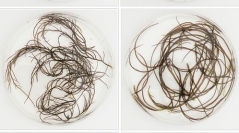

 Cryptogamie, Algologie
40 (7) - Pages 73-83
Cryptogamie, Algologie
40 (7) - Pages 73-83Pigment variation within and among algal species may have important ecological consequences because small changes in the concentration and composition of pigments can influence the photosynthetic efficiency and rate as well as the spectra of light utilized. Toward the goal of developing a rapid method for comparing pigment composition among algal thalli, we characterized the relationship between visual color information taken from photographs (e.g., red, green, and blue color values) and photopigment composition in the non-native red alga Agarophyton vermiculophyllum (Ohmi) Gurgel, J.N.Norris & Fredericq. We used a set of 19 thalli, collected from across the known native and non-native range in the Northern Hemisphere, which exhibited substantial color variation at the time of field collection, and sustained this variation after being maintained in a common garden. We identified a set of ecologically interesting pigment traits that are readily predicted by color information, including chlorophyll a and phycobilin concentration. Finally, we demonstrated the repeatability of estimating color phenotypes from photographs of thalli taken under a range of light conditions in order to evaluate the utility of this approach for field studies. We suggest this method could be useful for the rapid, high-throughput phenotyping of photopigments in other red algae as well.
intraspecific variation, ecology, photopigments, phycobilin proteins, Rhodophyta